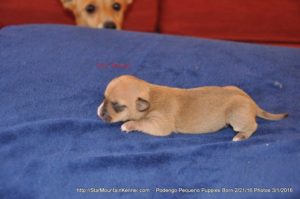 These are the tests the AKC recommends for the Portuguese Podengo Pequeno:
These are the tests the AKC recommends for the Portuguese Podengo Pequeno:
- HIP EVALUATION
- OPHTHALMOLOGIST EVALUATION
- PATELLA EVALUATION
These are the tests the Portuguese Podengo Pequeno Club of America recommends:
- Hip Evaluation for Hip Dysplasia
OFA Evaluation – OR
PennHIP Evaluation - Eye Examination by a boarded ACVO Ophthalmologist- min CERF age 12 months
Results registered with OFA – OR
Results registered with CERF - Patellar Luxation with OFA Evaluation
These are the tests we do on our breeding stock. Once tested we only use dogs with GOOD results for breeding. We take the health of our future puppies very seriously. We send happy, healthy puppies out into the world. Please ask to see the reports.
- Hip OFA Evaluation
- Elbow OFA Evaluation
- Patellar Luxation OFA Evaluation
- Eye Examinations by a boarded ACVO Ophthalmologist and registered with the OFA
- DNA Testing using the new Optimal Selection™ test. This tests for over 125 mutations in dogs. It is an important part of the trend toward predictive, preventive, and personalized healthcare for dogs. See below for a PARTIAL LIST OF THE TESTS PREFORMED.
- Progressive Retinal Atrophy, Progressive Rod-Cone Degeneration using DNA testing through Paw Print Genetics.
Not all breeders take advantage of the health tests available. This is important – Just because a dog has a CHIC number does not mean it has passed a health test. Always ask the breeder to see the actual health reports. We are a proud BRED with H.E.A.R.T Breeder.


-
Following is a partial list of diseases that are covered by the DNA Optimal Selection test.
-
Amelogenesis Imperfecta, (AI) Autosomal Recessive Severe Combined Immunodeficiency, (ARSCID) Bandera's Neonatal Ataxia, (BNAt) Benign Familial Juvenile Epilepsy or Remitting Focal Epilepsy Bleeding Disorder due to P2RY12 Defect Bobtail Canine Cyclic Neutropenia, Cyclic Hematopoiesis, Gray Collie Syndrome, (CN) Canine Multifocal Retinopathy 1, (CMR1); mutation found in Mastiff-related breeds Canine Multifocal Retinopathy 2, (CMR2); mutation originally found in Coton de Tulear Canine Multifocal Retinopathy 3, (CMR3); mutation originally found in Lapponian Herder Canine Scott Syndrome, (CSS) Cavalier King Charles Spaniel Muscular Dystrophy, (CKCS-MD) Centronuclear Myopathy, (CNM); mutation originally found in Great Dane Centronuclear Myopathy, (CNM); mutation originally found in Labrador Retriever Cerebellar Hypoplasia; mutation originally found in Eurasier Cerebral Dysfunction; mutation originally found in Friesian Stabyhoun Chondrodysplasia; mutation originally found in Norwegian Elkhound and Karelian Bear Dog Cleft Lip and Palate with Syndactyly; ADAMTS20 gene mutation originally found in Nova Scotia Duck Tolling Retriever Cleft Palate; DLX6 gene mutation originally found in Nova Scotia Duck Tolling Retriever Color Locus H (PSMB7 gene): Harlequin (H allele) Complement 3 (C3) Deficiency Cone Degeneration, (CD) or Achromatopsia Cone Degeneration, (CD) or Achromatopsia; mutation originally found in German Shepherd Cone Degeneration, (CD) or Achromatopsia; mutation originally found in German Shorthaired Pointer Cone-Rod Dystrophy 1, (crd1); mutation originally found in American Staffordshire Terrier Cone-Rod Dystrophy 2, (crd2); mutation originally found in Pit Bull Terrier Cone-Rod Dystrophy, (cord1-PRA / crd4) Cone-Rod Dystrophy, Standard Wirehaired Dachshund, (crd SWD) Congenital Hypothyroidism; mutation originally found in Tenterfield Terrier Congenital Hypothyroidism; mutation originally found in Toy Fox- and Rat Terrier Congenital Keratoconjunctivitis Sicca and Ichthyosiform Dermatosis, (CKCSID) Congenital Myasthenic Syndrome (CMS); mutation originally found in Jack Russell Terrier Congenital Myasthenic Syndrome (CMS); mutation originally found in Labrador Retriever Congenital Myasthenic Syndrome, (CMS); mutation originally found in Old Danish Pointing Dog Craniomandibular Osteopathy, (CMO) Cystinuria Type I-A; mutation originally found in Newfoundland Dog Cystinuria, Type II-A; mutation originally found in Australian Cattle Dog Degenerative Myelopathy, (DM) Dental Hypomineralization; mutation originally found in Border Collie Dilated Cardiomyopathy, (DCM); mutation originally found in Doberman Pinscher (USA) Duchenne or Dystrophin Muscular Dystrophy, (DMD); mutation originally found in Golden Retriever Duchenne or Dystrophin Muscular Dystrophy, (DMD); mutation originally found in Norfolk Terrier Early-Onset Progressive Polyneuropathy; mutation originally found in Alaskan Malamute Early-Onset Progressive Polyneuropathy; mutation originally found in Greyhound Epidermolysis Bullosa, Dystrophic; mutation originally found in Central Asian Ovcharka Epidermolysis Bullosa, Dystrophic; mutation originally found in Golden Retriever Epidermolytic Hyperkeratosis Episodic Falling Syndrome, (EFS) Exercise-Induced Collapse, (EIC) Factor IX Deficiency or Hemophilia B; mutation Gly379Glu Factor IX Deficiency or Hemophilia B; mutation originally found in Airedale Terrier Factor VII Deficiency Factor VIII Deficiency or Hemophilia A; mutation originally found in Boxer Factor VIII Deficiency or Hemophilia A; mutation originally found in German Shepherd Dog Factor VIII Deficiency or Hemophilia A; mutation originally found in Havanese Factor VIII Deficiency or Hemophilia A; p.Cys548Tyr mutation originally found in German Shepherd Factor XI Deficiency Fanconi Syndrome Fetal Onset Neuroaxonal Dystrophy, (FNAD) Focal Non-Epidermolytic Palmoplantar Keratoderma (FNEPPK) Glanzmann Thrombasthenia Type I, (GT); mutation originally found in Pyrenean Mountain Dog Globoid Cell Leukodystrophy or Krabbe Disease, (GLD); mutation originally found in Irish Setter Globoid Cell Leukodystrophy or Krabbe Disease, (GLD); mutation originally found in Terriers Glycogen Storage Disease Type Ia, (GSD Ia) Glycogen Storage Disease Type II or Pompe Disease, (GSD II) Glycogen Storage Disease Type IIIa, (GSD IIIa) GM2 Gangliosidosis; mutation originally found in Japanese Chin GM2 Gangliosidosis; mutation originally found in Toy Poodle Golden Retriever Progressive Retinal Atrophy 1, (GR_PRA 1) Golden Retriever Progressive Retinal Atrophy 2, (GR_PRA 2) Hereditary Ataxia or Cerebellar Ataxia; mutation originally found in Old English Sheepdog and Gordon Setter Hereditary Elliptocytosis Hereditary Footpad Hyperkeratosis, (HFH) Hereditary Phosphofructokinase (PFK) Deficiency Hereditary Vitamin D-Resistant Rickets, (HVDRR) Hyperekplexia or Startle Disease Hyperuricosuria, (HUU) Hypocatalasia or Acatalasemia Hypomyelination; mutation originally found in Weimaraner Ichthyosis; mutation originally found in Great Dane Intestinal Cobalamin Malabsorption or Imerslund-Gräsbeck Syndrome, (IGS); mutation originally found in Beagle Intestinal Cobalamin Malabsorption or Imerslund-Gräsbeck Syndrome, (IGS); mutation originally found in Border Collie L-2-Hydroxyglutaric Aciduria, (L2HGA); mutation originally found in Staffordshire Bull Terrier Lagotto Storage Disease, (LSD) Lamellar Ichthyosis, (LI) Ligneous Membranitis Macrothrombocytopenia; disease-linked variant originally found in Norfolk and Cairn Terrier May-Hegglin Anomaly (MHA) Mucopolysaccharidosis Type 3A, (MPS IIIA); mutation originally found in Dachshund Mucopolysaccharidosis Type VII, (MPS VII); mutation originally found in Brazilian Terrier Mucopolysaccharidosis Type VII, (MPS VII); mutation originally found in German Shepherd Multidrug Resistance 1 (MDR1 gene mutation) Muscular Dystrophy, Ullrich-type; mutation originally found in Landseer Muscular Hypertrophy (Double Muscling) Musladin-Lueke syndrome, (MLS) Myeloperoxidase Deficiency; mutation originally found in Italian Hound Myotonia Congenita; mutation originally found in Australian Cattle Dog Myotubular Myopathy; mutation originally found in Rottweiler Narcolepsy; mutation originally found in Dachshund Narcolepsy; mutation originally found in Labrador Retriever Neonatal Cerebellar Cortical Degeneration or Cerebellar Abiotrophy, (NCCD) Neonatal Encephalopathy with Seizures, (NEWS) Neuroaxonal Dystrophy; mutation originally found in Spanish Water Dog Neuronal Ceroid Lipofuscinosis 1, (NCL1); mutation originally found in Dachshund Neuronal Ceroid Lipofuscinosis 10, (NCL10); mutation originally found in American Bulldog Neuronal Ceroid Lipofuscinosis 12, (NCL12); mutation originally found in Tibetan terrier Neuronal Ceroid Lipofuscinosis 8, (NCL8); mutation originally found in Australian Shepherd Neuronal Ceroid Lipofuscinosis 8, (NCL8); mutation originally found in English Setter Osteochondrodysplasia; mutation originally found in Miniature Poodle Osteogenesis Imperfecta, (OI); mutation originally found in Beagle Osteogenesis Imperfecta, (OI); mutation originally found in Dachshund Persistent Müllerian Duct Syndrome, (PMDS); mutation originally found in Miniature Schnauzer Polycystic Kidney Disease in Bull Terriers, (BTPKD) Prekallikrein Deficiency Primary Ciliary Dyskinesia, (PCD) Primary Hyperoxaluria, (PH); mutation originally found in Coton de Tulear Primary Lens Luxation, (PLL) Primary Open Angle Glaucoma, (POAG); mutation originally found in Beagle Primary Open Angle Glaucoma, (POAG); mutation originally found in Norwegian Elkhound Progressive Early-Onset Cerebellar Ataxia; mutation originally found in Finnish Hound Progressive Retinal Atrophy Type III, (PRA type III); mutation originally found in Tibetan Spaniel and Tibetan Terrier Progressive Retinal Atrophy, (CNGA1-PRA); mutation originally found in Shetland Sheepdog Progressive Retinal Atrophy, (PAP1_PRA); mutation originally found in Papillon and Phalene Progressive Retinal Atrophy, (PRA); mutation originally found in Basenji Progressive Retinal Atrophy; Swedish Vallhund marker test Protein Losing Nephropathy, (PLN); NPHS1 gene variant Pyruvate Dehydrogenase Phosphatase 1 (PDP1) Deficiency Pyruvate Kinase Deficiency; mutation originally found in Beagle Pyruvate Kinase Deficiency; mutation originally found in Pug Pyruvate Kinase Deficiency; mutation originally found in West Highland White Terrier QT Syndrome Renal Cystadenocarcinoma and Nodular Dermatofibrosis, (RCND) Rod-Cone Dysplasia 1, (rcd1); mutation originally found in Irish Setter Rod-Cone Dysplasia 1a, (rdc1a); mutation originally found in Sloughi Rod-Cone Dysplasia 3, (rcd3) Sensory Ataxic Neuropathy (SAN) Severe Combined Immunodeficiency in Frisian Water Dogs, (SCID) Skeletal Dysplasia 2, (SD2) Spinal Dysraphism Spinocerebellar Ataxia with Myokymia and/or Seizures (SCA) Spinocerebellar Ataxia/ Late-Onset Ataxia (SCA, LOA) Spondylocostal Dysostosis Trapped Neutrophil Syndrome, (TNS) Van den Ende-Gupta Syndrome, (VDEGS) Von Willebrand's Disease (vWD) Type II X-Linked Ectodermal Dysplasia, (XHED) X-Linked Hereditary Nephropathy, (XLHN) X-Linked Hereditary Nephropathy, (XLHN); mutation originally found in Navasota Dog X-Linked Progressive Retinal Atrophy 2, (XLPRA2) X-Linked Severe Combined Immunodeficiency (XSCID); mutation originally found in Basset Hound X-Linked Severe Combined Immunodeficiency (XSCID); mutation originally found in Cardigan Welsh Corgi